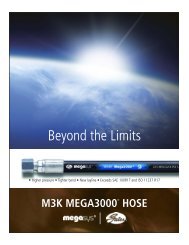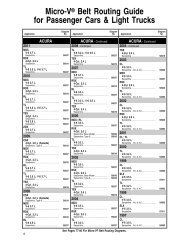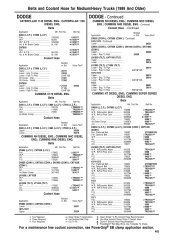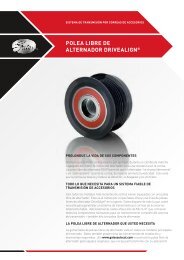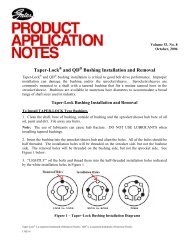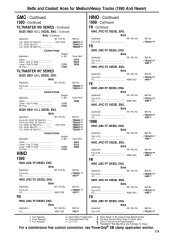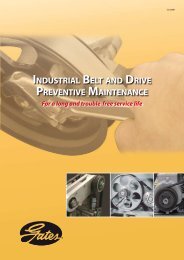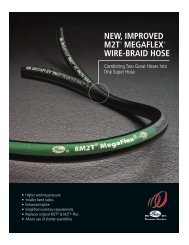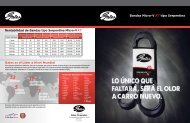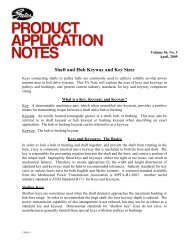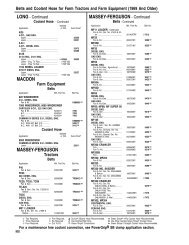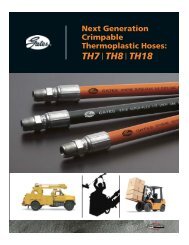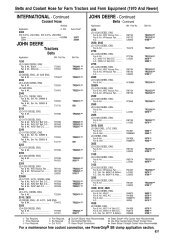PowerGrip® GT® Belt Drives
PowerGrip® GT® Belt Drives
PowerGrip® GT® Belt Drives
You also want an ePaper? Increase the reach of your titles
YUMPU automatically turns print PDFs into web optimized ePapers that Google loves.
Useful Formulas and Calculations<br />
Drive Design – continued<br />
The number of teeth in mesh on the smaller<br />
sprocket can be found as follows:<br />
Teeth in Mesh =<br />
(Arc) (n)<br />
360<br />
Where: Arc = Arc of contact; small sprocket, degrees<br />
n = number of grooves, small sprocket<br />
Drop any fractional part and use only the whole<br />
number as any tooth not fully engaged cannot be<br />
considered a working tooth.<br />
If the teeth in mesh is less than 6, correct the belt<br />
torque rating with the following multiplication<br />
factors:<br />
5 Teeth in Mesh – Multiply by 0.8<br />
4 Teeth in Mesh – Multiply by 0.6<br />
3 Teeth in Mesh – Multiply by 0.4<br />
2 Teeth in Mesh – Suggest Redesign<br />
1 Tooth in Mesh – Suggest Redesign<br />
Torque loading due to flywheel effect (acceleration<br />
or deceleration) can be calculated as follows:<br />
Torque (pound size 7 - inches) =<br />
0.039(RPM - rpm) (Wk 2 )<br />
t<br />
Where: RPM = Final revolutions per minute<br />
rpm = Initial revolutions per minute<br />
Wk2 = Flywheel effect, pound feet squared<br />
(lb-ft 2 ) (1 ft-lb-sec 2 is equivalent to<br />
32.2 lb-ft 2 )<br />
t = time, seconds<br />
Synchronous <strong>Belt</strong><br />
Tension<br />
Effective Pull<br />
T T - T S = 2(Q) = T e<br />
pd<br />
Where: T T = Tight side tension, pounds<br />
T S = Slack side tension, pounds<br />
Q = Torque Load, pound-inches<br />
pd = Pitch diameter, inches<br />
T e = Effective tension, pounds<br />
Total Tension<br />
T T + T S = 3(Q)<br />
pd<br />
Where: T T = Tight side tension, pounds<br />
T S = Slack side tension, pounds<br />
Q = Torque load, pound-inches<br />
pd = Pitch diameter, inches<br />
Tight Side Tension<br />
T T = 2.5(Q)<br />
pd<br />
Where: T T = Tight side tension, pounds<br />
Q = Torque load, pound-inches<br />
pd = Pitch diameter, inches<br />
Slack Side Tension<br />
T S = 0.5(Q)<br />
pd<br />
Where: T S = Slack side tension, pounds<br />
Q = Torque load, pound-inches<br />
pd = Pitch diameter, inches<br />
Centrifugal <strong>Belt</strong> Tension<br />
T c = (K c ) (pd) 2 (rpm) 2<br />
Where: T c = Centrifugal tension, pounds<br />
K c = <strong>Belt</strong> mass constant<br />
pd = Smaller pitch diameter, inches<br />
rpm = Smaller sprocket revolutions per<br />
minute<br />
Working Tension<br />
T w = (T e + T c) (SF)<br />
Where: T w = Working tension, pounds<br />
T e = Effective tension, pounds<br />
T c = Centrifugal tension, pounds<br />
SF = Service Factor<br />
The flywheel effect of a sprocket can be estimated as<br />
follows:<br />
Wk 2 (lb-ft 2 ) = (F) (Z) (D4 - d 4 )<br />
1467<br />
Where: F = Face width of rim, inches<br />
Z = Material density, pounds per cubic inch<br />
D = Outside rim diameter, inches<br />
d = Inside rim diameter, inches<br />
The World’s Most Trusted Name in <strong>Belt</strong>s, Hose & Hydraulics.<br />
89



